This week, Taiwan’s art scene mostly focuses on happenings in Taichung, kicking off with Art Taichung. In its fifth edition, the hotel art fair is spread across five floors and features 57 galleries, including Japan’s Gallery Kogure and Gallery Woo from South Korea, while Taiwan’s premium galleries and young spaces will survey the nation’s contemporary art scene. This year’s theme is sculpture and how people encounter public art in the city as well as the relation to how visitors view sculptures at an art fair. Special showcases include “Concepts and Status — A Special Exhibition of New Media Art” and “Young Voices.”
■ Millennium Hotel Taichung (台中日月千禧酒店), 77 Shizheng Rd, Taichung City (台中市市政路77號), tel: (04) 3705-6000.
■ Until Sunday from noon to 7pm

Photo courtesy of Soka Art Center
Chen Nien-tzu’s (陳念慈) delicate ink painting’s on paper are among the highlights of the group show, Insight into the Nature of Mind — The New Trace of Contemporary ink Art (觀心 — 當代水墨的新足跡). Chen’s seemingly realistic subjects are depicted by omission. In Moonlight, for example, the moon is not depicted directly, but through the reflection that plays with the perception of existence. Winnie Mak’s (麥翠影) traditional ink sketches are hypnotic meditations on people.
■ Da Xiang Art Space (大象藝術空間館), 15 Boguan Rd, Taichung City (台中市博館路15號), tel: (04) 2208-4288. Open Tuesdays to Sundays from noon to 8pm
■ Until Aug. 20
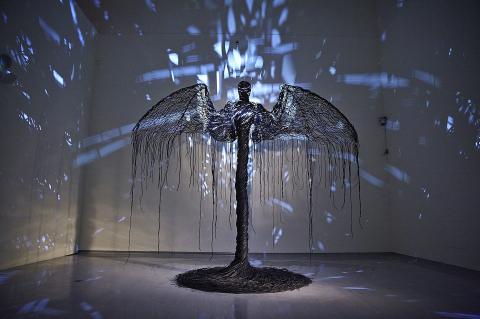
Photo courtesy of National Taiwan Museum of Fine Arts
Nick Dong’s (董承濂) installations are the result of meticulous designs that emphasize the beauty of light and reflection. In his solo show, Specular Reflection (鏡中實相), the artist delves into that space between reality and the unknown.
Visitors to the exhibition stil laif (靈魂機械鍊金術) will see Korean artist Choe U-ram’s (崔旴嵐) elegant mechanical installations. Choe’s ongoing investigation of the relationship between living organisms and machinery forms an interesting dialogue with Nick Dong’s works.
■ National Taiwan Museum of Fine Arts (國立臺灣美術館), 2, Wuquan W Rd Sec 1, Taichung City (台中市西區五權西路一段2號) tel: (04) 2372-3552, open Tuesdays to Fridays from 9am to 5pm, Saturdays and Sundays from 9am to 6pm
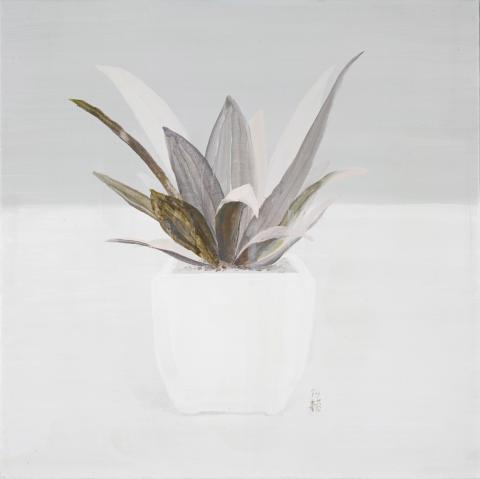
Photo courtesy of Ke-Yuan Gallery
■ Both exhibitions run until Sept. 3
Lee Meng’s (李檬) acrylic paintings have a strong focus on nature — more specifically, leaves — that are infused with a literati sensibility, giving rise to a novel form of the still life genre. The Green Breath (清涼吐納) suggests a strong duality of finding peace and relaxation — perhaps the reason her works are so appealing.
■ Ke-Yuan Gallery (科元藝術中心), 3-4F, 126-8 ChongShan Rd, Taichung City (台中市中山路126-8號3-4樓), tel: (04) 2622-9706. Open Tuesdays to Sundays from 11am to 6pm
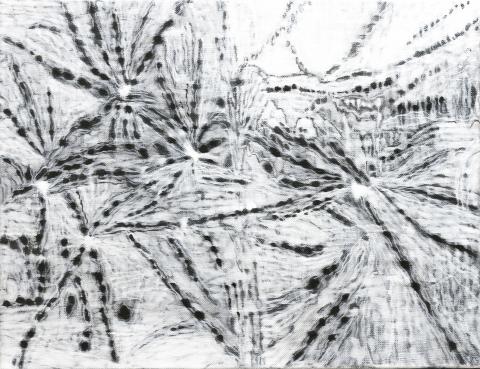
Photo courtesy of Yami Art Space
■ Until July 30
Cheng Hsien-yu (鄭先喻) presents Collector (收集者), which shows a series of odd mechanical structures, such as an installation of electric mosquito lamps connected to a gaming device with small insects. These futuristic works were made when the artist was living in the Netherlands from 2009 to 2013.
■ Yiri Arts Taichung (伊日藝術台中空間), 2 Jingcheng 5th St, Taichung City (台中市精誠五街2號), tel: (04) 2327-4361. Open Tuesdays to Sundays from 1pm to 7pm
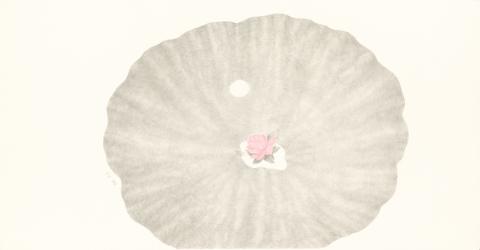
Photo courtesy of Da Xiang Art Space
■ Until Aug. 13
At The Endless Journey (無盡的旅程), Chen Shao-yen’s (陳劭彥) acrylic paintings, which appear to be ink on paper, will confound and fascinate in equal measure. Malaysian artist Tan Kent-keong (陳傑強) will show his oil paintings, which are imbued with a sense of the passing of time.
■ Yami Art Space (亞米藝術), 8, Aly 66, Ln 79, Sec 1, Xiangshang Rd, Taichung City (台中市向上路一段79巷66弄8號), tel: (04) 2301-2252. Open Tuesdays to Saturdays from 10am to 7pm
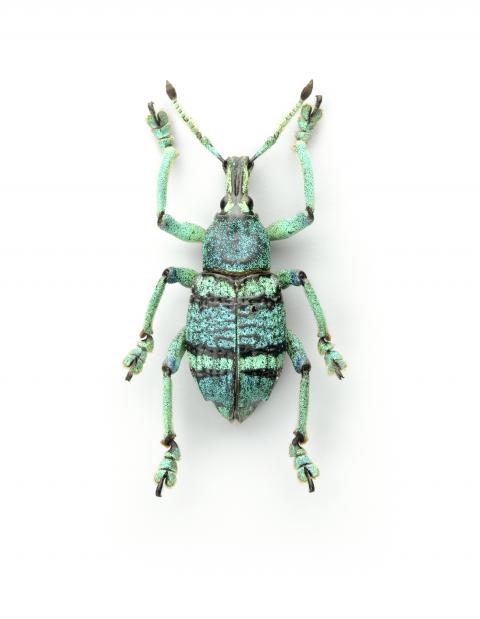
Photo courtesy of Soka Art Center
■ Until July 29
Daniel Eskenazi will present his first solo exhibition TIME/LIGHT (時/光). The use of Eskenazi’s long exposure photographs of natural patterns found in organisms like seashells and insects are gateways to further discovering the authenticity of the world as a philosophical experimentation.
■ Soka Art Center (索卡藝術中心), 350 Tiding Blvd Sec 2, Taipei City (台北市堤頂大道二段350號), tel: (02) 2533-9658. Open Tuesdays to Sundays from 10 am to 7pm
■ Opening reception tomorrow at 4pm; until Sept. 3

That US assistance was a model for Taiwan’s spectacular development success was early recognized by policymakers and analysts. In a report to the US Congress for the fiscal year 1962, former President John F. Kennedy noted Taiwan’s “rapid economic growth,” was “producing a substantial net gain in living.” Kennedy had a stake in Taiwan’s achievements and the US’ official development assistance (ODA) in general: In September 1961, his entreaty to make the 1960s a “decade of development,” and an accompanying proposal for dedicated legislation to this end, had been formalized by congressional passage of the Foreign Assistance Act. Two

March 31 to April 6 On May 13, 1950, National Taiwan University Hospital otolaryngologist Su You-peng (蘇友鵬) was summoned to the director’s office. He thought someone had complained about him practicing the violin at night, but when he entered the room, he knew something was terribly wrong. He saw several burly men who appeared to be government secret agents, and three other resident doctors: internist Hsu Chiang (許強), dermatologist Hu Pao-chen (胡寶珍) and ophthalmologist Hu Hsin-lin (胡鑫麟). They were handcuffed, herded onto two jeeps and taken to the Secrecy Bureau (保密局) for questioning. Su was still in his doctor’s robes at

Last week the Democratic Progressive Party (DPP) said that the budget cuts voted for by the China-aligned parties in the legislature, are intended to force the DPP to hike electricity rates. The public would then blame it for the rate hike. It’s fairly clear that the first part of that is correct. Slashing the budget of state-run Taiwan Power Co (Taipower, 台電) is a move intended to cause discontent with the DPP when electricity rates go up. Taipower’s debt, NT$422.9 billion (US$12.78 billion), is one of the numerous permanent crises created by the nation’s construction-industrial state and the developmentalist mentality it

Experts say that the devastating earthquake in Myanmar on Friday was likely the strongest to hit the country in decades, with disaster modeling suggesting thousands could be dead. Automatic assessments from the US Geological Survey (USGS) said the shallow 7.7-magnitude quake northwest of the central Myanmar city of Sagaing triggered a red alert for shaking-related fatalities and economic losses. “High casualties and extensive damage are probable and the disaster is likely widespread,” it said, locating the epicentre near the central Myanmar city of Mandalay, home to more than a million people. Myanmar’s ruling junta said on Saturday morning that the number killed had